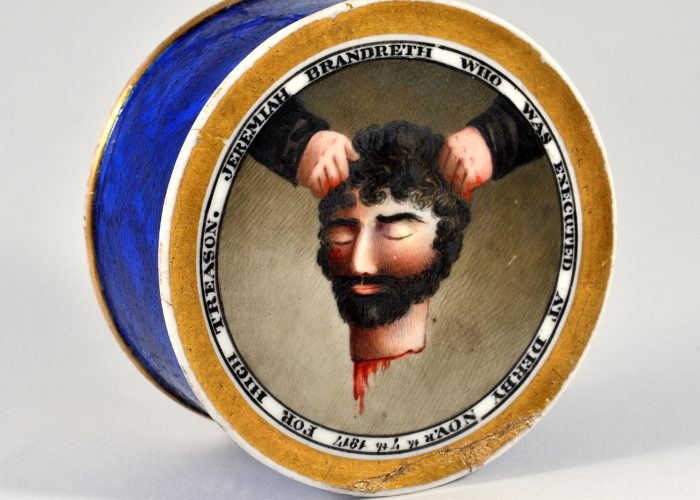Jeremiah Brandreth pot
Theme: Social and cultural revolution, Challenging law and order: British riots and reforms, The impact of industry
The Pentrich Rising was a small armed rebellion initiated by political radicals in the Midlands in 1817, which they hoped would spread far and wide and bring about revolutionary changes to the structure of government and society.
Deliberately infiltrated and partly provoked by government spies, the uprising was a failure, and the marchers scattered. The ringleaders were eventually caught and made an example of, through gruesome execution. The episode shared much in common with the coordinated protests that preceded it (the Luddites) and those that followed, including Peterloo. It exposed the tensions and frustrations within British society in the context of post–war economic unrest.
In June 1817, a group of over 300 miners, weavers and labourers, led by Jeremiah Brandreth, set out from the villages of Pentrich and South Wingfield in Derbyshire, for Nottingham, as part of what they believed would become a national uprising against the government. They had been told they would join at least 70,000 northerners marching south to ‘capture London’. But among them were a number of spies who had infiltrated the group and betrayed the protestors, informing the government of their plans. The crowd was already dispersing before it was intercepted by the army outside Nottingham, and Brandreth was later arrested along with two other ringleaders William Turner and Isaac Ludlum.
At the carefully fixed trial that followed, the three lead protestors were found guilty of treason and sentenced to death. They were hung and then beheaded with an axe. Other marchers were imprisoned, and some were transported to Australia and never returned. The trial was rigged, and the role of the spies hidden. This enabled the government to paint the poor rebels as vicious traitors and to intimidate other reformers and hungry and angry working-class people who may have been considering uprisings of their own.
When it was revealed that the uprising had been manipulated, in part, by the government and that it had also influenced the trial, there was an outcry. It led to a major debate in parliament and important changes in the law. In 1834 all the Pentrich marchers were pardoned.
Did you know..?
As well as this small commemorative porcelain pot depitcing the head of Jeremiah Brandreth, Derby Museum’s Collection includes the wooden block on which Brandreth, Turner and Ludlum were beheaded. It can still be seen in Pickford’s House Museum in Derby.
Use our Classroom resources to investigate this object and the theme of Protest further.
Highlights:
- Using objects, artworks and other sources to find out about the past
- Age of Revolution Top Trumps
- Enquiry: Why did workers protest in the Age of Revolution?
- How to make an interactive Revolutionary banner
- Twitter campaigns
And much more…
Sources & acknowledgements
This object description and its related educational resources were researched and written by our team of historians and education specialists. For further information see the item’s home museum, gallery or archive, listed above.
-
Did you know..?
The wooden block on which Brandreth, Turner and Ludlum were beheaded can still be seen in Pickford’s House Museum in Derby.
-
Education overview
You can access a range of teachers resources related to this object and more on our education page.
Please also see our glossary of terms for more detailed explanations of the terms used.
-
Curatorial info
- Originating Museum: Pickfords House, Derby Museums
- Accession Number: 1916-706/2
- Creator: Derby Porcelain Factory
- Material: Porcelain
- Creation Place: Derby Porcelain Factory
-
Use this image
You can download this image for personal and educational use but please take note of the license type and rights holder information.
- Rights Holder: © Derby Museums
- License Type:





